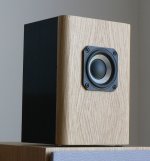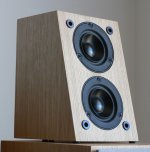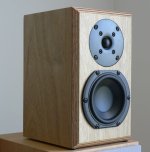Hi Everyone,
Just wondering if any of you multi-way speaker makers have tried making their own single driver desktop speakers?
You can make them super small, and of course they are simpler. No crossover, but maybe with some EQ.
I'm talking about "both kinds" of this, by the way. There are traditional "full range" driver makers like Fostex and Markaudio, as well as maybe midranges which can be adapted, like from Peerless and FaitalPro.
So my questions are two:
1 - How satisfied are you ?
2 - Did you learn something about single driver speakers?
Best,
E
Just wondering if any of you multi-way speaker makers have tried making their own single driver desktop speakers?
You can make them super small, and of course they are simpler. No crossover, but maybe with some EQ.
I'm talking about "both kinds" of this, by the way. There are traditional "full range" driver makers like Fostex and Markaudio, as well as maybe midranges which can be adapted, like from Peerless and FaitalPro.
So my questions are two:
1 - How satisfied are you ?
2 - Did you learn something about single driver speakers?
Best,
E
It's all horses for courses really. My idea of a single driver system is a small driver that can actually do high frequencies, without significant breakup, and without beaming like a lighthouse.
This means you aren't going to hit ear splitting SPLs, or get insane bass, but I don't think that was expected given the 'small desktop' intended application.
There are LOTS of terrible, or mediocre, full range drivers. But if you pick a good one and use it correctly then you really don't lose much, if anything, vs a multi-way speaker.
You'll be listening near-field, which most people don't do with their big speaker listening sessions, so the presentation is different. But you'll get all the superlatives/adjectives that audiophiles like to write about with the exception of so much bass the walls were shaking.
From my perspective the best thing to say is that they do sound 'small', but like a snow-flake, which is also small, when zoomed in, is perfectly formed. It's small sound but still contains/is capable of the magic that makes you smile.
For what it's worth I've tried the TG9 from Vifa/Peerless and it lacked high frequency extension. It was much better with a tweeter. The SB65WBAC, on the other hand, has amazing treble and lacks for nothing up there, neither does the W1-2121S. They absolutely need some EQ to compensate for what happens when you put speakers in boxes.
All it's taught me is that really small speakers can sound excellent but you need to make sure you pick your small speaker drivers carefully. You do not want ones with resonances and peaks left right and centre, nor do you want ones with a tiny xmax and no realistic way of making a decent stab at something considered bass. Far too many of them have tiny xmax and T/S parameters that don't work in anything other than a sealed box. That W1-2121S has a huge magnet and motor system for what it is, just so that it can work with a proper EBS alignment. You'll get bass down to 60-70Hz like that. The passive radiator(s) you use need to work correctly with the driver to get you there though. The design on my website isn't quite getting you there, but an updated version does. The SB65 needs a LT to provide adequate extension. Obviously it can't go loud like that, but we're not expecting it to. If you really want bass to go along with your tiny boxes then you add a dedicated sub.
I suppose what else it taught me is that there's nothing wrong with crossovers and multi-way either. And by wrong I mean intrinsically wrong. Some spout nonsense like 'you'll never reach audio nirvana unless you're using a wideband driver for something like 300Hz-20kHz.' This is stupid. Both design approaches need approaching correctly to make the most of what each can provide.
This means you aren't going to hit ear splitting SPLs, or get insane bass, but I don't think that was expected given the 'small desktop' intended application.
There are LOTS of terrible, or mediocre, full range drivers. But if you pick a good one and use it correctly then you really don't lose much, if anything, vs a multi-way speaker.
You'll be listening near-field, which most people don't do with their big speaker listening sessions, so the presentation is different. But you'll get all the superlatives/adjectives that audiophiles like to write about with the exception of so much bass the walls were shaking.
From my perspective the best thing to say is that they do sound 'small', but like a snow-flake, which is also small, when zoomed in, is perfectly formed. It's small sound but still contains/is capable of the magic that makes you smile.
For what it's worth I've tried the TG9 from Vifa/Peerless and it lacked high frequency extension. It was much better with a tweeter. The SB65WBAC, on the other hand, has amazing treble and lacks for nothing up there, neither does the W1-2121S. They absolutely need some EQ to compensate for what happens when you put speakers in boxes.
All it's taught me is that really small speakers can sound excellent but you need to make sure you pick your small speaker drivers carefully. You do not want ones with resonances and peaks left right and centre, nor do you want ones with a tiny xmax and no realistic way of making a decent stab at something considered bass. Far too many of them have tiny xmax and T/S parameters that don't work in anything other than a sealed box. That W1-2121S has a huge magnet and motor system for what it is, just so that it can work with a proper EBS alignment. You'll get bass down to 60-70Hz like that. The passive radiator(s) you use need to work correctly with the driver to get you there though. The design on my website isn't quite getting you there, but an updated version does. The SB65 needs a LT to provide adequate extension. Obviously it can't go loud like that, but we're not expecting it to. If you really want bass to go along with your tiny boxes then you add a dedicated sub.
I suppose what else it taught me is that there's nothing wrong with crossovers and multi-way either. And by wrong I mean intrinsically wrong. Some spout nonsense like 'you'll never reach audio nirvana unless you're using a wideband driver for something like 300Hz-20kHz.' This is stupid. Both design approaches need approaching correctly to make the most of what each can provide.
Yes a small fullrange driver used on a desktop nearfield can be very satisfying and quite charming. I actually use the SB65WBAC25-4 on my computer table (1.5m x 0.6m) as once all the gear goes on there there's little room. FLAC files from the computer > Audioquest Dragonfly > DTA-2 (Tripath TA-2024) > speaker (no sub required).
BTW, Troels did a little 2" Scan Speak for this purpose.
5F-8422T01
Played with this micro stuff for the last couple of years and some observations.
SB65WBAC25-4 which does work better than it should. The top end is a real surprise, nice mids and ample bottom end when vented. Plastic frame easy to break when adding or removing spade connectors so care required. I did 3 versions and I prefer the vented:
Vented Vb=1.36L, Fb=78Hz, F3=65Hz
Passive radiator Vb=1.3L, Fb approx 80Hz (SB12PAC-00 with half spider removed.
Also did a PVC pipe elbow version but the box version sounded better.
TG9FD10-04 which does a charming job. More relaxed presentation which makes for easy listening so it doesn't burn holes in your ears. The top end is not as good as the above but matches the overall sound and feel it's nicely balanced. I was going to add a tweeter (TN28) with it but not required.
Vented Vb=3L, Fb=80Hz, F3=65Hz, hump at 150Hz but doesn't distract from overall sound. Box is under size for better power handling and reduced excursion plus smaller build size. Flimsy plastic basket and a pain the add a 0.5mm gasket. Terminals aren't great for spade connectors.
NE95W-04 which is nicely made but lacks the top end so it needs a tweeter. Mids and bottom end is fine. The gap for the voice coil is small so it can rub if the cone is pressed on one side. Pushing it back evenly all the way fixes this.
Vented Vb=2.9L, Fb=87Hz, F3=69Hz
Eventually used sealed with 2 drivers in series for HT presence / atmos speaker depending on orientation. Sealed Vb=2.3L, F3=115Hz
I've also used Fostex, Tang Band and Mark Audio but can't remember much about them as long ago. A note on the F3 of small drivers is very different to the F3 on a much larger driver but still gives a good impression of bass (burp vs fart).
I did 2 other multiway micro speakers and as expected they out do the fullrange in the normal farfield listening positions but nearfield on desk the gap closes to a preference for the fullrange. The examples are shown below.
830870 + SB19ST-C000-4 - top end needs a tad more padding but fine elsewhere.
Vb=3.5L, Fb=84Hz, F3=72Hz
SB12PAC25-4 + NE19VTS-04 which is used nearfield above by workshop bench. A great little speaker and highly recommend the SB12PAC.
Vb=2.6L, Fb=78Hz, F3=72.
One thing I found with all the small speakers is a hump before the roll off is beneficial and makes the speaker sound more balanced.
All these were referenced against Jeff Bagby's Soprano in a small to medium room.
I've added some pics for reference.
BTW, Troels did a little 2" Scan Speak for this purpose.
5F-8422T01
Played with this micro stuff for the last couple of years and some observations.
SB65WBAC25-4 which does work better than it should. The top end is a real surprise, nice mids and ample bottom end when vented. Plastic frame easy to break when adding or removing spade connectors so care required. I did 3 versions and I prefer the vented:
Vented Vb=1.36L, Fb=78Hz, F3=65Hz
Passive radiator Vb=1.3L, Fb approx 80Hz (SB12PAC-00 with half spider removed.
Also did a PVC pipe elbow version but the box version sounded better.
TG9FD10-04 which does a charming job. More relaxed presentation which makes for easy listening so it doesn't burn holes in your ears. The top end is not as good as the above but matches the overall sound and feel it's nicely balanced. I was going to add a tweeter (TN28) with it but not required.
Vented Vb=3L, Fb=80Hz, F3=65Hz, hump at 150Hz but doesn't distract from overall sound. Box is under size for better power handling and reduced excursion plus smaller build size. Flimsy plastic basket and a pain the add a 0.5mm gasket. Terminals aren't great for spade connectors.
NE95W-04 which is nicely made but lacks the top end so it needs a tweeter. Mids and bottom end is fine. The gap for the voice coil is small so it can rub if the cone is pressed on one side. Pushing it back evenly all the way fixes this.
Vented Vb=2.9L, Fb=87Hz, F3=69Hz
Eventually used sealed with 2 drivers in series for HT presence / atmos speaker depending on orientation. Sealed Vb=2.3L, F3=115Hz
I've also used Fostex, Tang Band and Mark Audio but can't remember much about them as long ago. A note on the F3 of small drivers is very different to the F3 on a much larger driver but still gives a good impression of bass (burp vs fart).
I did 2 other multiway micro speakers and as expected they out do the fullrange in the normal farfield listening positions but nearfield on desk the gap closes to a preference for the fullrange. The examples are shown below.
830870 + SB19ST-C000-4 - top end needs a tad more padding but fine elsewhere.
Vb=3.5L, Fb=84Hz, F3=72Hz
SB12PAC25-4 + NE19VTS-04 which is used nearfield above by workshop bench. A great little speaker and highly recommend the SB12PAC.
Vb=2.6L, Fb=78Hz, F3=72.
One thing I found with all the small speakers is a hump before the roll off is beneficial and makes the speaker sound more balanced.
All these were referenced against Jeff Bagby's Soprano in a small to medium room.
I've added some pics for reference.
Attachments
rabbitz - tidy work on all those. That little 830870 is a lot of fun when used within its limits.
It should be no surprise to anyone that I’m quite fond of 3 -4” full-range drivers in smaller boxes for the very nearfield use - i.e. less than 1 meter - that desktop computer use implies. Along with compact class D / T amps with USB input such as Topping TP30 and judicious use of the EQ built into even the most modest PC/Mac music player software, it’s easy to achieve “charming” performance that I personally find more enjoyable than headphones, or any cheap Tupperware powered computer speakers I’ve ever tried. The much lamented late Monsoon desktop systems were very nice, but not as compact in total, and had issues with reliabilty of amp stages.
I’ve not tasted every offering on the wideband driver menu, so my personal favourites for this application- Fostex FF85WK and Alpair A5.2 - may not satisfy all palates.
It should be no surprise to anyone that I’m quite fond of 3 -4” full-range drivers in smaller boxes for the very nearfield use - i.e. less than 1 meter - that desktop computer use implies. Along with compact class D / T amps with USB input such as Topping TP30 and judicious use of the EQ built into even the most modest PC/Mac music player software, it’s easy to achieve “charming” performance that I personally find more enjoyable than headphones, or any cheap Tupperware powered computer speakers I’ve ever tried. The much lamented late Monsoon desktop systems were very nice, but not as compact in total, and had issues with reliabilty of amp stages.
I’ve not tasted every offering on the wideband driver menu, so my personal favourites for this application- Fostex FF85WK and Alpair A5.2 - may not satisfy all palates.
I was very happy with a pair of Audax AT100M0 in sealed boxes as desktop speakers. Shielded, which matters rather less these days, but most importantly they didn't need ports to reach below 100 Hz. Unfortunately the surrounds were foam, which rotted, so when I moved they went on the burn pile. Someday I'll see if there's newer fullranges with comparable sealed box suitability.
- Status
- Not open for further replies.





